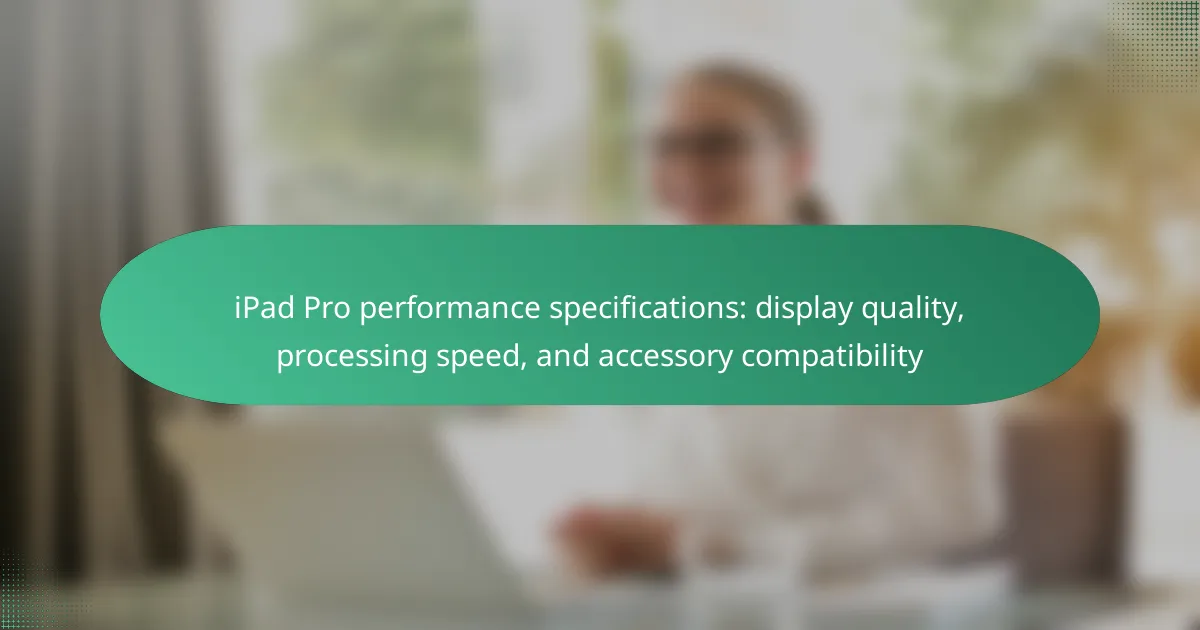The iPad Pro is a high-performance tablet featuring the M1 chip, which significantly boosts processing speed and efficiency. It offers display options of 11-inch and 12.9-inch Liquid Retina screens with ProMotion technology, supporting a resolution of up to 2732 x 2048 pixels for the larger model. With up to 16GB of RAM and storage configurations ranging from 128GB to 2TB, the iPad Pro is designed for demanding tasks and creative applications. Its battery life extends up to 10 hours on a single charge, and it is compatible with the Apple Pencil (2nd generation) and Magic Keyboard, enhancing productivity and usability.

What are the performance specifications of the iPad Pro?
The performance specifications of the iPad Pro include a powerful M1 chip, which enhances processing speed and efficiency. The device features an 11-inch or 12.9-inch Liquid Retina display with ProMotion technology. The display supports a resolution of up to 2732 x 2048 pixels for the 12.9-inch model. The iPad Pro offers up to 16GB of RAM, depending on the storage configuration. It provides storage options ranging from 128GB to 2TB. The battery life lasts up to 10 hours on a single charge. Additionally, it supports the Apple Pencil (2nd generation) and Magic Keyboard for enhanced productivity. These specifications make the iPad Pro suitable for demanding tasks and creative applications.
How does display quality impact the user experience of the iPad Pro?
Display quality significantly enhances the user experience of the iPad Pro. High resolution provides sharp images and text, making content more visually appealing. The Liquid Retina display supports a wide color gamut, resulting in vibrant colors and accurate representation. This feature is essential for creative professionals who rely on color precision in design work. Additionally, the ProMotion technology enables a smoother scrolling experience at 120Hz, reducing motion blur during fast-moving visuals. This fluidity improves overall navigation and interaction with apps. Furthermore, the True Tone feature adjusts the display’s color temperature based on ambient lighting, enhancing comfort during prolonged use. These attributes collectively contribute to a more immersive and enjoyable user experience on the iPad Pro.
What are the key features of the iPad Pro’s display?
The iPad Pro’s display features a Liquid Retina display with ProMotion technology. This display offers a resolution of 2732 x 2048 pixels. It supports a refresh rate of up to 120Hz for smoother visuals. The display is also equipped with True Tone technology for adaptive color temperature. It has a wide color gamut (P3) for enhanced color accuracy. The brightness reaches up to 600 nits for improved visibility in various lighting conditions. Additionally, it supports the Apple Pencil for precise input and drawing. These features collectively enhance the user experience for creative and productivity tasks.
How do resolution and color accuracy affect display performance?
Resolution and color accuracy significantly impact display performance. Higher resolution provides more pixels, resulting in sharper images and finer details. For example, a 2732 x 2048 resolution on the iPad Pro enhances clarity compared to lower resolutions. Color accuracy ensures that displayed colors closely match real-world colors. Displays with high color accuracy can reproduce over 99% of the sRGB color gamut. This precision is crucial for tasks like photo editing and graphic design. When both resolution and color accuracy are optimized, users experience improved visual quality and a more immersive viewing experience. Research shows that displays with higher resolution and better color accuracy lead to increased user satisfaction and productivity.
What factors contribute to the processing speed of the iPad Pro?
The processing speed of the iPad Pro is influenced by several key factors. The A-series chip, specifically the A12Z Bionic or A14X, provides significant processing power. This chip features an 8-core CPU and an 8-core GPU, enhancing multitasking and graphics performance. RAM capacity also plays a vital role; models with up to 16GB RAM can handle more applications simultaneously. The use of a high-performance SSD improves data access speeds, contributing to overall system responsiveness. Additionally, the iPad Pro’s software optimization ensures efficient resource management, maximizing processing capabilities. These elements combined lead to a seamless user experience on the iPad Pro.
What type of processor does the iPad Pro use?
The iPad Pro uses the Apple M1 processor. This chip features an 8-core CPU and an 8-core GPU. The M1 processor is known for its high performance and energy efficiency. It enables faster multitasking and improved graphics capabilities. The M1 is part of Apple’s transition to custom silicon for its devices. This transition enhances overall performance and software optimization. The M1 processor is capable of handling demanding applications seamlessly. It significantly boosts the iPad Pro’s performance compared to previous models.
How does RAM influence multitasking capabilities?
RAM directly influences multitasking capabilities by determining how many applications can run simultaneously. More RAM allows for more applications to be open without slowing down the system. For instance, devices with 8GB of RAM can handle multiple apps better than those with 4GB. This is important for tasks like switching between apps or running demanding software. According to benchmarks, systems with higher RAM show significantly improved performance in multitasking scenarios. This is evident in real-world tests where users report smoother transitions and less lag when using more RAM.
What accessories are compatible with the iPad Pro?
The iPad Pro is compatible with several accessories. These include the Apple Pencil, which allows for precise drawing and note-taking. The Smart Keyboard Folio provides a full-sized keyboard experience. There are also various USB-C accessories for charging and data transfer. Additionally, external displays can connect via USB-C for enhanced productivity. Apple’s Magic Keyboard enhances typing with a trackpad feature. Third-party accessories like cases and screen protectors are widely available. Each accessory is designed to enhance the iPad Pro’s functionality and user experience.
What types of accessories enhance the iPad Pro’s functionality?
Accessories that enhance the iPad Pro’s functionality include the Apple Pencil, Magic Keyboard, and various external storage options. The Apple Pencil allows for precise drawing and note-taking, making it ideal for creative professionals. The Magic Keyboard provides a laptop-like experience with a trackpad and comfortable typing. External storage options, like USB-C drives, expand the iPad Pro’s storage capacity, enabling users to manage larger files. Additionally, screen protectors and cases offer protection while maintaining usability. These accessories collectively improve productivity and user experience.
How does accessory compatibility affect performance?
Accessory compatibility directly influences the performance of devices like the iPad Pro. When accessories are designed specifically for the iPad Pro, they ensure optimal functionality and efficiency. For instance, compatible keyboards and styluses enhance productivity and user experience. In contrast, using non-compatible accessories can lead to reduced performance or functionality. For example, third-party chargers may not provide the correct power output, affecting charging speed. Similarly, incompatible cases might interfere with device cooling, leading to thermal throttling. Research shows that using certified accessories can improve overall device responsiveness and longevity. Thus, accessory compatibility is crucial for maintaining high performance in devices like the iPad Pro.
How do display quality, processing speed, and accessory compatibility interact?
Display quality, processing speed, and accessory compatibility are interrelated aspects of device performance. High display quality requires sufficient processing speed to render graphics smoothly. For instance, a Retina display with high resolution demands more processing power to maintain frame rates. Accessory compatibility, such as with Apple Pencil or external displays, also relies on processing speed for effective functionality. If processing speed is insufficient, accessories may not perform optimally with high-quality displays. Therefore, these three elements work together to enhance the overall user experience.
What practical tips can improve the performance of the iPad Pro?
To improve the performance of the iPad Pro, regularly update the operating system. Keeping iOS updated ensures access to the latest optimizations and features. Close unused apps to free up system resources. This action can enhance multitasking capabilities. Manage storage effectively by deleting unnecessary files and apps. A full storage can slow down performance significantly. Disable background app refresh for non-essential apps. This reduces strain on the processor and battery. Use a wired connection for data transfer when possible. Wired connections are faster than wireless options. Additionally, consider using the iPad Pro with compatible accessories. High-quality accessories can enhance functionality and performance.
The iPad Pro is a high-performance tablet featuring an M1 chip, a Liquid Retina display with ProMotion technology, and various accessory compatibility options. Key specifications include a display resolution of up to 2732 x 2048 pixels, up to 16GB of RAM, and storage options ranging from 128GB to 2TB. The article covers how display quality enhances user experience, the impact of processing speed on multitasking, and the importance of compatible accessories for optimal performance. Additionally, it provides practical tips to improve the iPad Pro’s functionality and efficiency.
